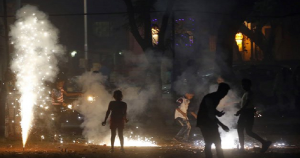
Air Quality In Delhi Worsens, Pollution Level 23 Times Higher Than Normal On Diwali!
A day after Diwali, the capital’s pollution levels have worsened due to the bursting of fire crackers. According to real-time ambient air quality data of the Delhi Pollution Control Committee, the national capital on Diwali night witnessed a severe rise in the pollution levels with the suspended particulate matter reaching as much as 23 times higher than normal in Anand Vihar, arguably the most polluted spot of the city.

Every year, the pollution levels in Delhi, one of the most polluted cities of India, increase as Diwali draws closer. And this year too, was no different despite rallies and campaigns to celebrate the festival of lights without crackers.
Every year, the pollution figures start to increase around 6 pm on the day of Diwali, tend to peak between 10 pm & midnight and remain unhealthy till about 6 am the next day. In Anand Vihar, this year at around 11 pm, the PM10 was recorded at 2,308 micrograms per cubic meter (mpcm) while the prescribed standard is 100mpcm. Similarly, PM2.5 for which the prescribed standard is 60mpcm also touched an alarming high at 619mpcm at midnight in this heavily polluted area in East Delhi.
At RK Puram, PM10 was at its peak at 1 am at 1,333mpcm while PM2.5 touched 985mpcm at 9.20pm. In Punjabi Bagh, the PM2.5 was at its peak at 1 am and was recorded at 638mpcm, while PM10 was recorded as 1,033mpcm highest also at 1 am. However, according to the DPCC air quality index, a downward trend was witnessed since 2 am across the monitoring stations.

The IGI Airport station of System of Air Quality, Weather Forecasting and Research (SAFAR) showed a severe reading of PM 2.5 and PM 10 at 325 micrograms per cubic metre and 452 micrograms per cubic metre respectively at around 3 pm.
The air quality may worsen further as reports suggest that the level of particulate matter (PM2.5) is likely to increase by 148 percent due to polluting firecrackers. Delhi University was the most polluted spot in the city with PM2.5 touching an average of 430 mg per cubic metre, which is a ‘severe’ reading, and the air quality here is expected to deteriorate further and clock up to 485 in the next 24 hours.
Experts say these particulate matters which are way above the permissible limit are extremely dangerous for people suffering from asthma and other respiratory and cardiac problems, and also for children and the elderly.